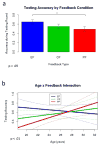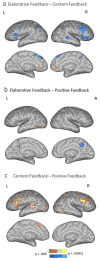Elaborative feedback: Engaging reward and task-relevant brain regions promotes learning in pseudoword reading aloud
- PMID: 29209999
- PMCID: PMC5864461
- DOI: 10.3758/s13415-017-0553-5
Elaborative feedback: Engaging reward and task-relevant brain regions promotes learning in pseudoword reading aloud
Abstract
Although much is known about the cognitive and neural basis of establishing letter-sound mappings in learning word forms, relatively little is known about what makes for the most effective feedback during this process. We sought to determine the neural basis by which elaborative feedback (EF), which contains both reward-related and content-specific information, may be more helpful than feedback containing only one kind of information (simple positive feedback, PF) or the other (content feedback, CF) in learning orthography-phonology (spelling-sound) mappings for novel letter strings. Compared to CF, EF activated the ventromedial prefrontal cortex, implicated in reward processing. Compared to PF, EF activated the posterior middle temporal, superior temporal, and supramarginal gyri-regions implicated in orthography-phonology conversion. In the same comparison, EF also activated the left fusiform gyrus/visual word form area-implicated in orthographic processing. Also EF, but not CF or PF, modulated activity in the caudate nucleus. In a postscan questionnaire, EF and PF were rated as more pleasant than CF, suggesting that modulation of the caudate for EF may be due to the coupling of reward and skill content. These findings suggest the enhanced effectiveness of EF may be due to concurrent activation of reward-related and task-relevant brain regions.
Keywords: Feedback; Orthography; Phonology; Reading; Reward.
Figures






Similar articles
-
Testing for dual brain processing routes in reading: a direct contrast of chinese character and pinyin reading using FMRI.J Cogn Neurosci. 2002 Oct 1;14(7):1088-98. doi: 10.1162/089892902320474535. J Cogn Neurosci. 2002. PMID: 12419131
-
From orthography to phonetics: ERP measures of grapheme-to-phoneme conversion mechanisms in reading.J Cogn Neurosci. 2004 Mar;16(2):301-17. doi: 10.1162/089892904322984580. J Cogn Neurosci. 2004. PMID: 15068599 Clinical Trial.
-
Functional anatomy of intra- and cross-modal lexical tasks.Neuroimage. 2002 May;16(1):7-22. doi: 10.1006/nimg.2002.1081. Neuroimage. 2002. PMID: 11969313 Clinical Trial.
-
Neural systems for perceptual skill learning.Behav Cogn Neurosci Rev. 2002 Mar;1(1):76-83. doi: 10.1177/1534582302001001005. Behav Cogn Neurosci Rev. 2002. PMID: 17715587 Review.
-
Skill learning: bringing cognition to its senses.Curr Biol. 1998 Jul 30-Aug 13;8(16):R572-4. doi: 10.1016/s0960-9822(07)00364-8. Curr Biol. 1998. PMID: 9707394 Review.
Cited by
-
Patterns and networks of language control in bilingual language production.Brain Struct Funct. 2021 May;226(4):963-977. doi: 10.1007/s00429-021-02218-7. Epub 2021 Jan 27. Brain Struct Funct. 2021. PMID: 33502622
References
-
- Alexander MP, Fischer RS, Friedman R. Lesion Localization in Apractic Agraphia. Archives of Neurology. 1992;49(3):246–251. https://doi.org/10.1001/archneur.1992.00530270060019. - DOI - PubMed
-
- Arnett JJ, Jensen J. Emerging adulthood: A theory of development from the late teens through the twenties. American Psychologist. 2000;55(5):469–480. https://doi.org/10.1037/0003-066X.55.5.469. - DOI - PubMed
-
- Baayen RH, Davidson DJ, Bates DM. Mixed-effects modeling with crossed random effects for subjects and items. Journal of Memory and Language. 2008 https://doi.org/10.1016/j.jml.2007.12.005. - DOI
-
- Barbey AK, Koenigs M, Grafman J. Dorsolateral prefrontal contributions to human working memory. Cortex. 2013;49(5):1195–1205. https://doi.org/10.1016/j.cortex.2012.05.022. - DOI - PMC - PubMed
-
- Bhattacharya A, Ehri LC. Read and Spell Words. Journal of Learning Disabilities. 2004;37(4):331–348. https://doi.org/10.1177/00222194040370040501. - DOI - PubMed
Publication types
MeSH terms
Grants and funding
LinkOut - more resources
Full Text Sources
Other Literature Sources

